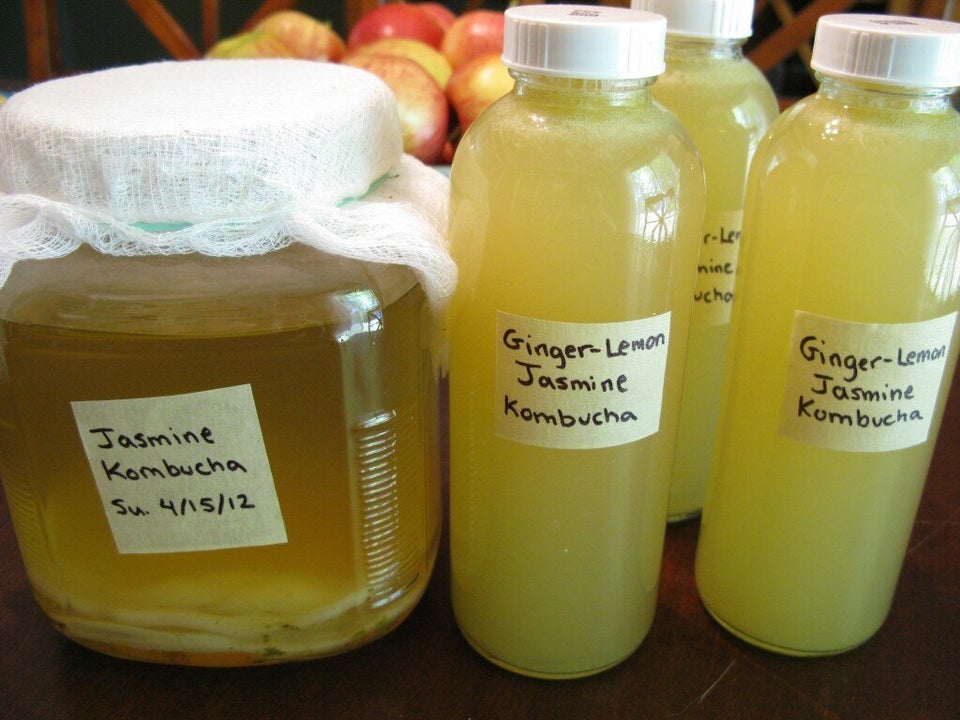
In a short period of time, kombucha has gone from a drink for hippies — and nobody but — to the mainstream.
This bubbly beverage, made from the fermentation of tea, has a long (and often mysterious) history, but it’s simple to make on your own: all you need is brewed tea, some sugar, a SCOBY (the culture of bacteria and yeast used to ferment the tea), and some time.
If you're feeling creative and want a flavour you can't seem to find anywhere, you’re only limited by your imagination. The particular rules that must be followed are usually specific to brewing large quantities of kombucha to be sold, says Zoey Shamai, founder of Tonica Beverages Ltd. But Shamai experiments at home with different flavour combinations, often using fresh fruits.
Stephen Lee began brewing kombucha after being introduced to the drink in Russia, where he met an elderly lady who had been brewing it since 1939 — using the same culture for fifty years. He went back to Portland with his own SCOBY from hers and began experimenting, eventually leading to his own company Kombucha Wonder Drink. Now he’s co-written a book, "Kombucha Revolution", that gives instructions not only for starting your own kombucha but also for customizing your brews with infusions, or even using kombucha to make other foods and drinks.
Inspired? Check out these 20 ways to do more with your kombucha, from flavour infusions to who other foods and drinks. Or take your own idea and run with it. As Shamai advised, it never hurts to experiment.
1. Ginger: Zoey Shamai, founder of Tonica Beverages Ltd. says that ginger is a flavour that always works with kombucha. “It takes out some of the acidity and the bite of kombucha, and gives it a nice smooth flavour,” she said. You can infuse kombucha with ginger alone, or add complementary flavours like the lemon in this recipe from The Paleo Mom.
2. Wild Blueberry: Tart wild blueberries are a great choice for infusing kombucha, Shamai suggests — the kombucha culture will ferment a bit further, as well, thanks to the natural sugar in the fresh berry juice. You can add pure blueberry juice to get your desired flavour, or mash in whole blueberries. "Then you’re getting the benefit of all the antioxidants and vitamins in the fruit as well as the benefits of the kombucha,” Shamai explained.
Check out this recipe at Civilized Caveman Cooking.
3. Mojito: The flavours of classic cocktails have endured for a reason: they work well together. You can use those flavours for other drinks as well — for example, in this mint-infused recipe for a mojito-flavoured kombucha from Healing Cuisine By Elise.
4. Sangria: The perfect summer drink, and one that's endlessly customizable, is great with kombucha added to the mix instead of club soda or a lemon-lime soda. You can use plain kombucha, or choose a flavour that goes with the fruits you’re including in your sangria — this one from Choosing Raw uses cranberry kombucha, for example.
5. Jasmine: It’s generally advised to brew kombucha with unflavoured black, green, or white teas, because the essential oils can interfere with the fermentation process. However, Shamai does recommend one exception: jasmine. “I’ve found that when you ferment jasmine green tea, it’s the most lovely flavour,” she said.
Check out Cultures For Health for tea suggestions.
6. Sassafras: For another unexpected combination, Shamai recommends infusing kombucha with sassafras to get a drink that tastes like a Caesar. If you like your Caesars spicy, try adding some whole or lightly ground spices to the infusion as well — for example, black peppercorns — and then straining them out before you drink. Sassafras is also a key ingredient in traditional root beer.
7. Pomegranate And Whiskey: Cocktails aren’t only good for providing inspiration for kombucha flavours — you can use the drink in the cocktails themselves, like this one from Honest Cooking that has the unexpected combination of pomegranate and whiskey.
8. Margarita: Toronto's Queen West bar Fonda Lola makes a great kombucha margarita, Shamai said — but you can try this recipe from Holistic Squid at home if you don’t live in Toronto.
9. Lavender: You may not think of plants like lavender when you think of beverages — florals are more often associated with fragrances than food. But many are edible, and can provide a lovely counterpoint to the somewhat bracing flavour of kombucha. This recipe from Kombucha Revolution uses lavender with a green tea base.
Lavender–Green Tea Kombucha
Makes 1 gallon
15 1/2 cups purified water
16 to 20 tea bags or 8 tablespoons (35 grams) loose-leaf black tea
1 cup evaporated cane sugar
2 cups starter tea
1 SCOBY
4 tsp chopped fresh lavender buds, or 2 tsp dried
Heat 6 cups of the water in a stainless steel saucepan over medium heat to 170°F, then remove from heat. Add the tea, stir well, and cover. Steep for 4 minutes, stirring once at 2 minutes. Remove the tea bags or pour tea through a colander or fine-mesh strainer into a second pot. Compost the tea.
Add the sugar and stir until dissolved. Then add 8 cups of water to cool the tea to about room temperature (72°F or cooler). Add the starter tea and stir. Pour into a 1-gallon jar. With rinsed hands, carefully lay the SCOBY on the surface of the tea. Cover the opening of the jar with a clean cotton cloth and hold it in place with a rubber band.
Place the jar in a warm spot (72°F to 78°F) out of direct sunlight and leave undisturbed to ferment for 7 days.
Taste the kombucha, using a straw. Does it taste too sweet? Let it go a few more days before tasting again.
Is it sufficiently tart and you love it? Great! Time for the next step.
Carefully remove the SCOBY with rinsed hands and place on a clean porcelain or glass plate or bowl bathed in kombucha. This will be your culture for the next batch.
If immediately proceeding with another batch, reserve about 2 cups of the finished kombucha for the starter tea of your next brew.
To steep the lavender, put the buds in a suitable tea ball, cheesecloth, or loose-leaf tea brewing device. Bring the remaining 1 1/2 cups of water to a boil.
Use 1/2 cup of the hot water to warm the container in which you’ll steep the lavender.
Pour it off.
Add the lavender to the container. Pour the hot water over, cover, and allow to steep for 5 minutes, but no longer than 5 minutes; lavender can go bitter. Remove the lavender and allow to cool to room temperature.
Using the funnel and spouted measuring cup (for easy pouring), divide the lavender infusion equally among the bottles (about 2 tablespoons per 16-ounce bottle). Fill the bottles with the green tea kombucha, leaving 1 inch of air space in the neck. As you pour, you may want to use a fine-mesh strainer to filter out yeast strands. Cap tightly.
To begin the optional secondary fermentation, simply store the capped bottles in a warm dry place (72°F to 78°F is best) for 48 hours. Be aware that the sugars present will add fuel to the fermentation action in the bottle, which will increase the pressure inside the bottles. After 48 hours, chill one of the bottles for at least 6 hours. Crack it open and pour into a glass. If it effervesces, you’ve done it! If you want more carbonation, let it go for a few more days and test another chilled bottle. When you’re pleased with the carbonation, refrigerate all the bottles to end the fermentation.
Credit: Reprinted with permission from Kombucha Revolution by Stephen Lee, copyright (c) 2014. Published by Ten Speed Press, an imprint of Random House LLC.
10. Apple Cider: Many of the flavours we’ve suggested use spring and summer produce, but kombucha infusions are delicious all year round. This apple cider-inspired recipe is perfect for fall, for example. You could also try to make a kombucha infused with a bit of pure pumpkin pulp and some pumpkin pie spices like cinnamon.
11. Peach: In-season fruits are great in kombucha — choose your favourites from what is best fresh right now, and use it to flavour your own brews. Peach’s sweetness is a good balance for kombucha, to give one example of a fruit that works well.
12. Coffee: Cold-brewed coffee is wonderful when the weather warms up — but what if it were also even better for your health? This recipe uses coffee instead of the traditional tea with a kombucha SCOBY to make a fermented coffee drink. No heating allowed, or you’ll risk killing all that great gut-friendly bacteria.
13. Popsicles: You don’t only have to drink kombucha. Try freezing it for refreshing, low-cal ice pops when the weather warms up. This berry recipe is a great choice but you can try it with any of your favourite flavours.
Find out how to make this at Stalkerville.
14. Gummies: If you make kombucha regularly, you end up with a lot of leftover scobies. You can pass them along to friends who want to make kombucha of their own, but you can also use them to make all-natural gummies.
15. Sourdough Starter: Kombucha isn’t the only food that’s fermented, which means that you can use kombucha to get different cultures going. Equal parts of kombucha and a flour of your choosing (gluten-free or regular) can be used to make a starter for sourdough bread that’s ready in just one day.
16. Ice Cream Floats: The combination of cool ice cream in bubbly soda is a summer class, and you can make it a bit healthier by replacing the soda with ice cream. This is also a good way to make a too-sour batch of kombucha palatable.
17. Smoothie: Are you a smoothie fan? Try replacing some of the liquid you’d typically include, whether it’s water or milk, with kombucha to give your blends a probiotic kick.
18. Chia: One company, GT’s Kombucha, sells a chia-kombucha mixture that combines two superfoods into one healthful drink. You can make it on your own as well, easily: simply put a tablespoon of chia seeds into a glass of your favourite kombucha, let it sit until the seeds have absorbed enough moisture to reach your desired consistency, then enjoy.
19. Pickling: Sometimes you let a brew get too far and it turns into something unappealingly vinegary, but that doesn’t mean it’s gone to waste. Think of how you would use vinegar, and use the over-fermented kombucha the same way: for example, to pickle some of spring’s best fresh produce.
20. Vinaigrette: Along the same lines, you can also use kombucha to replace vinegar in vinaigrette. This recipe from "Kombucha Revolution" makes a basic vinaigrette, but you could also switch it out in your own favourite recipe.
Kombucha Vinaigrette
Feel free to enhance your vinaigrette with ingredients such as minced onion, garlic, herbs, salt, pepper, lemon, or honey for a dash of sweetness.
Makes 1 cup
1/4 cup Kombucha Vinegar
3/4 cup extra-virgin olive oil
1 teaspoon ground mustard seeds
Coarse ground sea salt
Freshly ground black Pepper
Combine the kombucha vinegar with the olive oil, mustard, salt, and pepper to taste. Whisk together until combined. Pour over a salad or refrigerate in a sealed container for up to 1 week.
Credit: Reprinted with permission from Kombucha Revolution by Stephen Lee, copyright (c) 2014. Published by Ten Speed Press, an imprint of Random House LLC.
